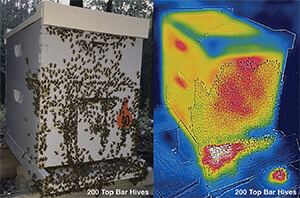
As autumn comes upon us, the nights become cold while warm afternoons seem to cling to fleeting memories of summer. Ever vigilant all through the heat of summer, the bees have protected their precious combs by constantly patrolling them. Now after sunset, the invading cold comes. The bees must withdraw from the outer realm of the brood combs. If cold enough, not a bee remains on the honeycombs above. A cluster forms at the former brood nest. The cells there are mostly empty. This time is called the brood pause.
A single-comb observation hive is like a slice of a full-size colony. Figure 1 shows the cluster formed over the empty part of the brood comb. Surrounding the bees from above is the band of honey. Strangely, that wealth of concentrated energy seems unguarded. The cold prevents attack by other insects. Wax moths, both species (greater and lesser), could never infest it in the cold. Those pests might as well be a million miles away. Small hive beetles cannot ruin the honeycombs with their nasty disgusting slime, even though they are merely inches away. The adult beetles, easily dozens of them, spend the winter inside the cluster, living off of the honey and heat of the bees.
While the cold renders bare comb off limits to bees and their insect comb destroyers, if a destructive agent could endure the cold, the bees would be helpless against it. Enter the mouse. Earlier than beekeepers may realize, which I found out unexpectedly.
Over a four-year period, I conducted a large observational study of varroa mite population growth and the mites’ resistance to tau-fluvalinate, the miticide in Apistan®, formulated in plastic strips. I had 100 top-bar hives with screen floors and sticky boards. To keep up with current conditions, I counted varroa mites right in the apiaries. While that was a hardship (I counted over 400,000 varroa mites), I learned various unexpected things along the way. One was about mice.
When the weather turned cold enough for night clustering, mice began entering my hives, chewing the combs. The damage was minor, but it showed the mouse activity occurred surprisingly early. The evidence appeared on my version of a sticky board, a metal sheet coated with vegetable oil, and read for mites within a couple of days. In a top-bar hive, a horizontal hive, all the combs are directly above the sticky board. Therefore, debris on the sticky board fell from the combs directly above. The falling debris also formed patterns, telling a story as shown by Figure 2. For orientation, we are viewing the sticky board from the entrance end of the hive. (The entrances were to the right.) The cluster was to the upper left, as indicated by the lines of debris falling from between the combs. (The linear clear places were actually under the combs.) Away from the cluster to the lower right are larger bits of chewed wax. Right above that location was where the mouse had chewed the comb. The smaller pieces of wax fell through the screen floor and on the sticky board; the larger pieces were on the screen just above. The mouse entered the hive through the entrances at the right, apparently staying away from the bees further in the hive to the left.
When the weather warmed, allowing the bees to break cluster, and reoccupy the periphery of the brood combs, they repaired the damage. Inadvertently, the bees help conceal the early forays of the mouse into the hive. That was also at a time when beekeepers were not conducting detailed brood nest inspections anyway. So in all from the mouse and bee behavior, the first mouse invasions were stealthy and cryptic. Hardly detectable. For bee management, the lesson is clear: install mouse guards on the hives early, just before the nights turn cold (see Figure 3).
Recognizing with confidence the symptoms of mouse activity in the hive is an important beekeeping attribute. Mice typically eat pollen from the pollen band, leaving combs weak, oftentimes worthless. As they gnaw the combs, pieces of wax fall on the floor of the hive or they may appear on the alighting board. Their size is important.
Bees opening honey cells (capping-cutter bees), robber bees, and mice all produce roughly different sized pieces of wax when they gnaw comb. (Some size overlap occurs, but with the current conditions, one can figure out what produced the pieces of wax.) In early spring (sometimes fall too) capping-cutter bees chew-open caps and move honey closer to the cluster. They produce fine bits of wax. In mass robbing when bees become intensely excited to rob honey from comb, particularly new comb, they gnaw away the cell walls. The size of the pieces is much larger than that made by the capping-cutter bees, but generally smaller than the pieces made by a mouse gnawing the comb (see Figures 4 and 5).
Dead bees–headless–are apparently another less appreciated mouse symptom. It is well known that mice eat pollen, a protein source with presumably a sweet taste to them (from the pollen mixed with nectar). That seems straightforward and reasonable. Less so is mice eating …


